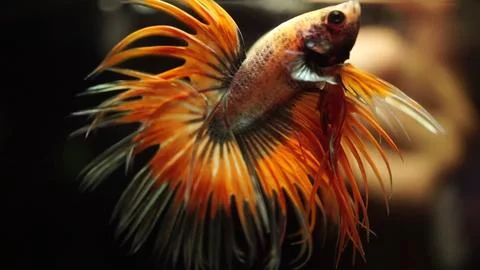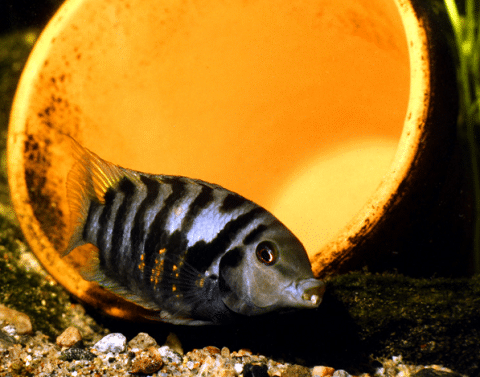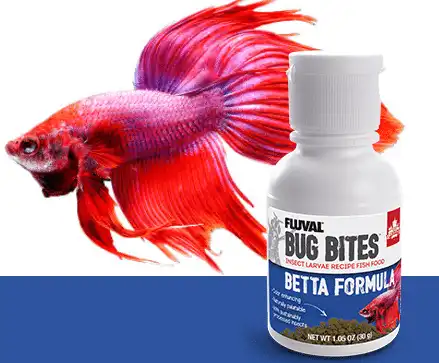Thank you for visiting! By the way… any links on this page that lead to products on Amazon and other stores/partners are affiliate links Aquarium Store Depot earns a commission if you make a purchase.
The spectacular appearance and distinct fin shapes of the Crowntail Betta fish have entranced many devoted aquarists worldwide. With a long history and unique behaviors, these captivating creatures demand special care to keep them in their best health. Here we present an extensive guide into all you need to know when it comes to looking after your own Crowtail Bettas – from understanding where they come from to maintaining optimal conditions for breeding bettas, right up until preventing any illnesses affecting your precious fish!
This post hopes that by exploring this unique Betta species, you’ll be able to access appropriate resources and knowledge on providing the necessary care and construct a suitable environment. Making sure each crowntail is healthy and happy within its new home. So let’s traverse deep down the waters together – discovering along our journey everything there is about keeping & caring for our crowntail betta.
Key Takeaways
- Crowntail Bettas are known for their unique crown shaped tails and can live 2-5 years with the right care.
- Create an ideal environment by setting up at minimum a 5 gallon tank if solo, or 10 gallons with other aquatic animals
- Adjust water parameters, add decorations and enrichment, and feed them small meals 12 hours apart.
- Introduce compatible tank mates slowly to prevent aggression.
- Breeding requires proper preparation for successful offspring.
Species Overview
| Scientific Name | Betta splendens |
| Common Names | Crowntail Betta |
| Family | Gourami |
| Origin | Thailand |
| Diet | Omnivore |
| Care Level | Beginner |
| Activity | Slow to Moderate |
| Lifespan | 2 – 5 years |
| Temperament | Peaceful (Aggressive to own kind) |
| Tank Level | Middle to top |
| Minimum Tank Size | 5 gallon |
| Temperature Range | 76°-81°F |
| Water Hardness | 5 to 20 DH |
| pH Range | 6.5 – 8.0 (for most varieties) |
| Filtration/Water Flow | Low |
| Water Type | Freshwater |
| Breeding | Egg-layer |
| Difficulty to Breed | Easy to breed |
| Compatibility | Community fish (when with other species) |
| OK, for Planted Tanks? | Yes |
Introduction
Crowntail Bettas, a variant of the Siamese fighting fish, are a popular freshwater fish species native to Southeast Asia. Their name comes from the characteristic shape of their caudal fin, which looks like a crown with its reduced webbing and spiky appearance. These labyrinth fish have an extraordinary ability thanks to their organ: they can breathe air, allowing them to live in shallow rice paddies located in their natural environment.
Unfortunately, this beautiful creature is often kept inside small containers or bowls due to its combative instincts among members of its own kind. This type of atmosphere isn’t suitable for crowntails since it has negative effects on both lifespan and health conditions, leading folks like me to understand more thoroughly these animals’ unique needs so I can teach others how to properly care for them.
In order to provide you with complete information about bettas, we will explore elements such as origin, appearance traits, ideal habitat setups, feeding habits alongside breeding so that Crowtail Bettas get the treatment that matches all respective requirements.
Origins And History
The Siamese Fighting fish, now known as Betta splendens, has a long history in the native region of Southeast Asia where it was originally bred for fighting. This breed caught the attention of British ichthyologists and officially named them Betta splendens. The distinctive form and colors that we know today are due to Achmad Yusuf’s selective breeding efforts back in 1997. Upon their appearance at an International Bettas Congress show, they became wildly popular with all kinds of fish keepers worldwide. Other betta species still originate from this part of southeast Asia while crowntail bettas will always remain unique among other types of fish thanks to these modern developments beginning over 20 years ago.
Appearance

The Crowntail Bettas stand out with their distinct shape and striking colors. A slender body that narrows at the mouth is framed by an upturned hinged supra-terminal jawline that is trademark of the Betta fish. The signature feature of these vibrant creatures are their fins. They have reduced webbing on their tail fins to create a spiky or crown-like look. Male specimens especially shine in this regard due to long flowing fin rays while females’ shorter versions still retain the Crown Tail characteristic appearance.
The diversity among Crowtail Bettas’ coloring and patterns never ceases to amaze aquarists. From black/brown bodies accented by iridescent blues and greens to brighter spikes tipped with red—they make any aquarium really pop! Their beauty has made them one of the most iconic Betta species.
Lifespan
When it comes to the longevity of a Crowntail Betta, their life span could be between 2 and 3 years, with 5 years being the max observed. Lifespan will depend on how good care they receive. The elements that will determine this are the quality of water in its tank, the water temperature setting as well as the size and stress levels within its living quarters. To guarantee an extended lifespan for your fishy friend, providing them with clean surroundings and steady conditions along with feeding it properly is essential.
Diet is also a major factor. All of which we will discuss as we go further in this blog post.
Average Size
Crowntail Bettas usually reach between 2.5 and 3 inches in length, depending on a variety of elements such as the betta’s diet, genetics, and sub-type. To calculate your particular crowntail Betta’s size precisely, simply use a ruler or measuring tape to measure from its nose all the way to the tail fin’s tip. These lovely creatures have long become beloved by hobbyists for their stunning beauty due to selective breeding with different colors and striking fins shapes resembling those of crown tails!
Types (5 in Total)
Crowntail Bettas are a widely popular betta species, offering up five different types:
- Single Ray
- Double Ray
- Triple Ray
- Random Ray
- Cross Ray Crown Tail
It is important to note that the ideal Crowntail Betta is defined as having a balance between the empty spaces between the fin rays and the remaining fin webbing. It’s important as a purchaser to know the differences so you can purchase the most ideal specimen for your tank. With that being said, let’s talk about the 5 types.
1. Single Ray

The Single Ray Crowntail Betta has a single ray that separates from its tail edge. This is the most common Crowntail Betta available in the hobby and is often assumed by hobbyist as the only Crowntail around.
2. Double Ray
Double Rays are similar to Single Rays, except there are two rays coming out from the tail edge instead of one. The webbing of the fins are reduced at two levels – one level reduced between pairs of rays and the other level is reduced between the two ray branches. In the Betta community, the Double Ray Crowntail Betta is referred to as the ideal Crowntail
3. Triple Ray

For the triple ray (image source), you have three “rays” now that extend beyond the tail end . This Crowntail Betta type is considered uncommon and difficult to produce. If you find one at a store, consider yourself lucky and pick it up right away if it looks healthy as it likely won’t be around for long!
4. Cross Ray
Considered the most desirable and expensive of the lot. This is also known as the King Crowntail Betta. This fish has two crossing rays that extend past its tail forming a cross shape on each end. This crossing only occurs on the tail end. The bottom and top fins will have traditional single rays. The most prestiagous sub-variety of this type is the Venom, which is an all black variety. It is considered one of the rarest Betta species in the hobby.
5. Random Ray
With the random ray Crowntail Betta, each ray can be split into single or multiple rays and will split again randomly.
Other Mislabeled Types
There are some species of Betta that are often confused or mislabeled in the hobby. The first is the conetail, which has a tail fin that resembles a crowntail betta, but the pectoral fins are completely unique. The fin extensions are not as long as the crowntail betta.
The other type is called the Suntail. It is a crossbreed of the half-moon and the crowntail betta fish. It has a 180 tail spread like the Half Moon, but the caudal fin webbing of the crowntail.
Creating The Ideal Environment
When taking care of a Crowntail Betta, providing the ideal habitat is essential to ensure their health and happiness. It’s important to set up an appropriate aquarium with the right tank size as well as adequate filtration and oxygenation systems.
To mimic their natural environment, fine sand or gravel should be used for substrate while dim lighting should be provided in order to create a comfortable atmosphere for your tropical fish. Artificial caves along with plants, make perfect hiding spots that will offer safety while avoiding sharp edges or rough surfaces on decorations since these can damage its delicate fins.
Natural sand is excellent for bottom feeder fish to forage around in.
When considering tank design, it’s key that Bettas have access to space and labyrinth organs needed so they can breathe air above water level surface area, and build their bubble nests. By following all of these factors carefully you’ll successfully create an optimal living situation catered specifically towards crowtail betta needs!
Tank Size And Requirements
When it comes to a Crowntail Betta, an aquarium of at least 10 gallons is the most suitable tank size that closely resembles their natural habitat in shallow rice paddies. Having this kind of spaciousness and length allows for adequate room for swimming and exploration purposes. That being said, you can be okay with a 5 gallon if you just want to keep a single Betta, but who want to keep your fish lonely?
The perfect first time aquascaper tank. Comes with dragonstone rock. Just add filtration and plants!
In order to ensure your fish lives happily with optimal water conditions, make sure you equip the tank with necessary elements such as a filter, heater, and thermometer. Filters need to be gentle. A sponge filter is often used. However, if you want to keep other fish or a planted tank, consider upgrading to a power or canister filter, just put a sponge on the intake and lower the flow rate.
The Best Aquarium Power Filter
The worlds best selling and most reliable power filter on the market. Unchanged for years because it's so reliable and versatile
Water Parameters And Conditions
For the best health and overall well-being of your Crowntail Betta fish, it is important to maintain proper water conditions. Aim for a pH level between 6.4 and 7.0 with hardness levels from 2 dKh up to 5 dkh as well as temperatures staying in the range 76-80 Fahrenheit degrees in order to keep them happy within their tank environment inside an aquarium or similar setting.
To create a more naturalistic environment to stabilize parameters, Indian almond leaves may be added, which release beneficial tannins.
These leaves can be added to your aquarium to help promote a natural habitat for bettas, shrimp, and other soft-water loving fish. Betta breeders can use these leaves to help encourage breeding behavior.
Regular maintenance such as cleaning the tank, checking parameters regularly (via test kits), plus changing some portions of the water will keep your fish happy and healthy. Always remember to make water changes based on the maintenance of your parameters, typically when one of these key parameters is out of wack:
Tank Decorations And Enrichment
When creating the perfect environment for your Crowntail Betta, it’s best to replicate their natural habitat. Floaters are an ideal choice since they provide places of refuge and emulate shallow rice paddies that these fish inhabit in nature. Additionally, rounded decorations such as rocks make great areas to explore while remaining safe on delicate fins.
Finally, bedding of either gravel or fine sand is essential when mimicking their native abode – giving them somewhere familiar yet gentle on those same fin-tails!
Feeding
It is essential for a Crowntail Betta to consume an adequate diet full of high-protein elements such as live foods, pellets, flakes and frozen items. A varied menu helps keep the fish healthy with vibrant coloring while offering them all they need for growth. It’s important not to overfeed. Instead, stick to feeding small meals two times daily. Betta will eat fast. Give them enough so they will devour their food in less than a minute.
Protein Sources
Ensuring that Crowntail Bettas get a balanced and nutritious diet involves offering them an array of protein sources. Live or frozen items such as bloodworms, brine shrimp, mosquito larvae, and daphnia are great for this purpose, while high-grade pellet fish foods also supply essential nutrients. Frozen and live foods offer the most benefits, but it is easy to overfeed with frozen, and you can introduce parasites with live foods. We recommend frozen food when your fish is housed with others and cultivating your own live foods. Fluval bug bites are a great pellet food to feed your Betta. Highly recommended as a main source.
Best Betta Food
Fluval bug bites is made of various insect and shrimp ingredients making this a high quality source of protein
For optimal health benefits, it is important to offer your crowtail betta multiple forms of nutrition from several food sources. Rotate out several foods so they have everything necessary for proper growth.
Crowntail Betta Health And Disease Prevention
Crowntail Bettas must be kept in a clean and healthy environment to stay as healthy as possible. To ensure this, regular water changes should occur and provide them with a balanced diet. Common illnesses that can plague these fish include parasitic infections, bacterial issues, fin and tail rot, fungal disease, etc., which will require quarantine for the affected fish while the appropriate medications are given out.
Signs that your fish may have contracted one of these diseases include:
- Pale patches on their body
- Clamped fins or frayed tails
- An overall decrease in activity
- Rapid breathing
- White spots on fins or scales
It is important to remember that several diseases could arise if their health isn’t monitored properly. By being vigilant in maintaining your Crowtail Betta’s well being, you can help prevent any potential sickness from happening or reduce its chances of spreading among other living creatures within an aquarium setting.
Choosing Compatible Tank Mates For Crowntail Bettas
Crowntail Bettas are known to be territorial and aggressive. They can peacefully coexist with compatible tank mates under the right circumstances.
Peaceful animals that are small enough not to get attacked by bettas make for ideal companions – these include:
- Nerite snails
- Bamboo shrimp
- African dwarf frogs
- Otocinclus catfish
- Cory Catfish
- Kuhli loaches
- Harlequin rasbora
- Neon tetras
It’s important to keep an eye on both your Crowntail Betta and any potential roommates’ behavior so you can quickly address signs of aggression if needed while maintaining a safe space for them all.
Bad Tank Mates

For Crowntail Bettas, certain species should be excluded as tank mates due to aggression or mismatches in compatibility. It is best to avoid other fish with long and flowing fins since they tend to draw the attention of these bettas more often than others. Here are other fish to avoid:
- Goldfish – different parameters
- Cichlids – too aggressive, including Angelfish and Dwarf Cichlids
- Danios – too activity and will overcompete with your fancy finned Betta
- Cherry shrimp – your Betta will eat them
- Any fish large enough to fit your Betta in its mouth
When it comes down to what type of companions you add to your aquarium, always take care not just from an aesthetic perspective but prioritize the health and well being of your betta over all else.
Breeding
For fish keepers, breeding Crowntail Bettas is an exciting experience and a great reward. Before starting the process, there are several steps one must take in order to properly prepare for their bettas’ mating ritual.
It’s best if you feed your crowntails with high-protein meals at least 10 days prior and set up a separate tank specifically made for the breeding of these lovely creatures. The male will start building its bubble nest nearby floating plants as soon as it spots potential mates. Then they’ll move on to perform what seems like their wedding dance until she releases her eggs that he subsequently fertilizes afterward before carefully transferring them all into his precious bubbly home where he shall remain vigilant from then onwards guarding it until they finally hatch!
Crowtail Breeding can be quite taxing but also very rewarding ultimately – so don’t let any obstacles stand between you and those little miracles waiting inside your tanks. Now swim away together towards love (and success!).
Mating And Breeding Behavior
This fish is polygamous in nature, meaning it can mate with several other partners if the opportunity arises.
For breeding purposes these Betta males build bubble nests for their eggs to be laid into while simultaneously fertilizing them until they hatch out. Once that process has been completed, the male then takes on his duty of guarding his brood until fully developed from egg form to adult size aquatic animals within days or weeks depending on certain environmental conditions.
When female and male Crowntail Bettas are prepared to mate, they swim close together. The males will fan their fins at each other as a sign of attraction, and if the female is receptive she’ll release her eggs into the water for fertilization by him. Afterward, he carefully crafts his bubble nest using saliva mixed with air bubbles in order to house them securely until they hatch. At this stage, bettas remain protective guardians of these soon to be fry.
In captivity, when the eggs hatch and the fry are free swimming, be sure to remove the male so the fry can grow without getting eaten. You should remove the female after the eggs are placed in the bubble nest.
Frequently Asked Questions
Are Crowntail bettas more aggressive?
For aquarists who want a lively tank, Crowntail Bettas may be the perfect fish. These bettas often have more aggressive tendencies compared to other betta fish varieties – which is why it’s recommended that they are kept solo in their tanks or in a larger community aquarium. Male bettas are generally more aggressive than females.
Are Crowntail bettas less aggressive?
Crowntail bettas are known for their aggression, so if you’re searching for a calm fish, they may not be the best choice. However, they generally are aggressive towards their own kind and tend to get bullied by many other fish. Providing plenty of vegetation and hiding places in larger tanks can also help reduce aggressiveness among crowntail betta fish.
Can Crowntail bettas live with other fish?
It is possible for crowntail bettas to live with other fish species, as long as they have the same water requirements and get along in terms of temperament and size. Care must be taken when introducing any new tank mates to observe whether there may be aggression towards the betta or not. The larger the tank, the higher the chance of success since aggression can be curbed with additional space. This rule especially applies to all kinds of fish, including crowntails.
What is the life expectancy of a Crowntail betta?
The life expectancy of crowntail bettas is Two to three years, making them an easy commitment for those looking into having one as a pet. Through good care and the right environment, it is possible that their lives can be extended.
Closing Thoughts
In this detailed guide, we have delved deep into the fascinating world of Crowntail Betta fish. We discussed where they come from, how they look, and what their care requirements are—including breeding. If you provide a suitable environment with an appropriate diet and regular attention to detail then your baby will stay healthy for years to come.
With all that said in mind, it’s important that aquarists give these beautiful fish plenty of love and devotion if they’re going to achieve optimum health down the line. Through our exploration here, hopefully we’ve provided enough insight so owners can take proper steps in raising their own crowtail bettas!
Have you kept a Crowntail Betta before? If so, leave a comment in the comment section. We love hearing from our readers. Let’s start a conversation. Until next time!
- About the Author
- Latest Posts
I’m thrilled that you found Aquarium Store Depot! Here you’ll find information on fish, aquariums, and all things aquatics related. I’m a hobbyist (being doing this since I was 11) and here to help other hobbyists thrive with their aquariums! I adhere to a high quality Editorial Process and Review products with real life field usage and practical analysis.










